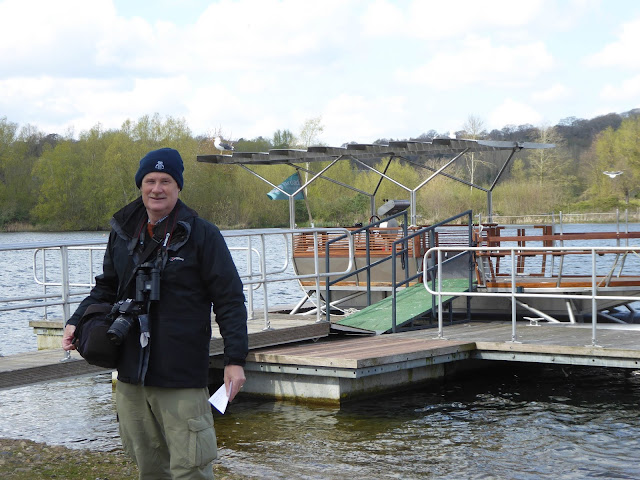 |
| Strumpshaw Fen: there were plenty of wonderful reedbed vistas |
We spent the last morning of our Norfolk holiday at RSPB Strumpshaw Fen, a place I should have known very well since it was only a matter of miles from my first Norfolk home. For some reason I had never to my knowledge been out and about on this particular part of the Yare Valley before.
It was a bitterly cold April morning (about a week before Easter); but, as you can see, there were glorious spells of sunshine to set off the panoramic skyscapes.
When you arrive at this nature reserve, you have to cross an old-fashioned railway crossing. We checked the line carefully before proceeding to the RSPB cabin, and were thankful to find that you can buy hot coffee - and drink it with wonderful views like the one above through the hide-style windows.
We knew we didn't have very long as we had booked ourselves on a boat trip on the other side of the river - so we slurped our coffee and set off on the boardwalk towards the river Yare.
I wonder what is happening a the old Strumpshaw Pumping Station: is it a work of renovation, with those ladders and fence? In Victorian times this station was operated by steam. It was later upgraded to electricity.
We rarely see Coltsfoot in our area so it was a joy to find this splash of yellow. Apparently it can tolerate most soils except ones that are particularly acidic. Cockchafers are partial to the underground stems.
By noon the sky was a dark grey and the river Yare had a deep metallic sheen about it. We soon found ourselves pelted by hailstones. It was time, in any case, to head back to the car so that we could cross the river on the outskirts of Norwich. Many have marvelled at Mark Cocker's Crow Country: a number of the places he writes about and the remarkable corvid murmurations that he portrays with such verve are a few kilometres downstream from here - i.e. on round the bend in the photo above - on, and a bit beyond.
By lunchtime we had reached Whitlingham, and after a quick picnic in the car, we braved the elements and set sail on Whitlingham Broad, aboard the solar-powered Ra. This was something I had wanted to do for ages, and what a wonderful experience it was. The Ra is an accessible vessel, equipped to take folk with mobility issues and those in wheelchairs. There was a green ramp (see below) which meant no one had to clamber over the side.
I spent most of my teenage years close by, on this southern side of the river, but had never previously had the opportunity to venture out on to Whitlingham Broad. It was *COLD*, bitterly cold but bracing, and I think I wore nearly as many coats and scarves as I did when we took the ferry to Ellis Island off New York in the snow one January.
 |
| The Ra, a good platform for wildlife-spotting |
 |
| The train opposite might well be going to pass through the crossing at Strumpshaw... |
Can you see the
The Mute Swan preferred the bank...
...and, as you can see, it (she?) wasn't alone.
We were joined by the boatman and by another family and were soon out on the water in our life-jackets. This stretch of water used to be a gravel pit, and, if my memory serves me rightly, was 40 foot deep!
As we neared the other side, a Cormorant came into view. There were various waterbirds flapping about in front of us.
The Ra is a wonderful resource and we thoroughly enjoyed our ride. We made our way back to land passing groups of young people learning to sail and weaving their way through the wind.
Our final destination was Surlingham (where we were married many years ago). Surlingham is almost opposite Strumpshaw Fen. After a mug of Earl Grey and a superb pastry in a Polish farm cafe-patisserie we made our way down to the marsh, passing St Mary's, with one of the 124 existing round towers (Norman, in this case, with a 14th century octagonal top) in the county ...
We soon reached the nearby ruined church of St Saviour's...
 |
| St Saviour's, dating from 12th century and used for regular worship until 1705 |
It is a lovely, natural and tranquil spot - and I can see why local naturalist, Ted Ellis (1909–1986), was buried here. Our visit to this tucked-away corner seemed the perfect end to our Norfolk adventure.
















































